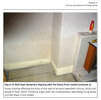Is that the one where the house had already been treated with a chemical DPC?It's worth reading the report carried out by Salford Uni a few years ago. It's goes into detail about how moisture gets through the mortar joints after a number of years. They had the finance to carry out a number of surveys on older, damp properties. Rising damp has always been difficult to reproduce in the lab.
The problem with Peter Ward's site for me is that he makes stupid statements, such as ' rising damp was invented in 1962' and the UK is the only country with a rising damp industry'.
Even Jeff Howell, who wrote the book, has had to come round to the fact he was wrong.
That a mockery of the whole study.


